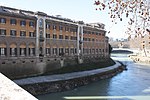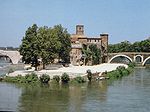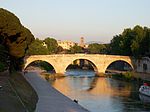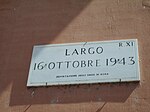Temple of Faunus

The Temple of Faunus (Latin: aedes Fauni) was an ancient Roman temple on the southern end of the Tiber Island in Rome, dedicated to Faunus, the god of flocks. It was the only temple with that dedication in Rome itself. It was a hexastyle prostyle built in 196 BC by Gnaeus Domitius Ahenobarbus and Gaius Scribonius Libo and financed by a fine they had imposed on the shepherd of a flock which (probably) had accidentally grazed for free on a public field. It was dedicated in 194 BC on the Ides of February, anticipating by two days the major Roman festival of Faunus, the Lupercalia. If still in use by the 4th-and 5th century, it would have been closed during the persecution of pagans in the late Roman Empire.
Excerpt from the Wikipedia article Temple of Faunus (License: CC BY-SA 3.0, Authors, Images).Temple of Faunus
Via di Ponte Quattro Capi, Rome Municipio Roma I
Geographical coordinates (GPS) Address Website Nearby Places Show on map
Geographical coordinates (GPS)
| Latitude | Longitude |
|---|---|
| N 41.891 ° | E 12.476 ° |
Address
Fatebenefratelli
Via di Ponte Quattro Capi
00153 Rome, Municipio Roma I
Lazio, Italy
Open on Google Maps










